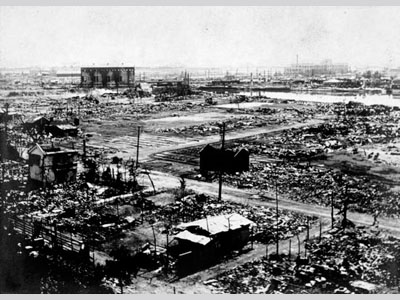On midday, September 1, 1923, the city of Tokyo and its surrounding areas were hit with a magnitude 8.3 earthquake. Just moments after the initial shock, the wind significantly picked up as a typhoon passed off the coast of the Noto Peninsula in Northern Japan.
The storm produced very little rain, however its winds were significant. As most residents were preparing lunch when the earthquake hit, and with open fire as the general cooking method at that time, the shock caused the cooking fires to escape their bounds and grow. The 97 km/h (60 mph) winds of the nearby typhoon spread the flames and created horrifying firestorms. Because the earthquake had caused water mains to break, the fires were not put out until late in the morning on 3 September. The fires were the biggest causes of death. Had the typhoon produced more rain, the death toll of 99,300 would have potentially been much lower and the complete devastation of the city far less. Fast Facts:
Sources:
Vischer, Stephen S. “Tropical Cyclones and Earthquakes.” Bulletin of the Seismological Society of America. 1924. Vol.14, No. 3, Pp 181 – 184. Morozova, L.I. “Typhoons and Seismicity.” Doklady Earth Sciences. 2006. Vol. 410, No. 7, Pp 1132 – 1135. Web. Hammer, Joshua. Yokohama Burning: The Deadly 1923 Earthquake and Fire That Helped Forge the Path to World War II. New York: Free Press, 2006. Lovgren, Stefan. “Earthquake Fault Under Tokyo Closer Than Expected, Study Finds.” National Geographic. 14 Jul. 2005. Web. “Great Kanto Earthquake.” Wikipedia. 2009. Web. James, Charles D. (2002-10-08). "The 1923 Tokyo Earthquake and Fire" http://nisee.berkeley.edu/kanto/tokyo1923.pdf The Great Kanto Earthquake of 1923: Materials from the Dana and Vera Reynolds Collection A Brown University Library Digital Collection |


